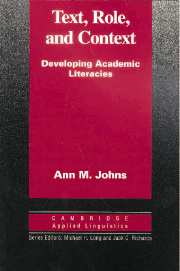Book contents
- Frontmatter
- Contents
- Series editors' preface
- Preface
- Acknowledgments
- 1 Literacy and pedagogy: Three views
- 2 Genre knowledge and socioliteracies: What readers and writers may share
- 3 Genre and social forces: “Homely” and academic texts
- 4 Discourse communities and communities of practice: Membership, conflict, and diversity
- 5 Special roles: Literacy practitioners as campus mediators and researchers
- 6 Students as researchers: Investigating texts, processes, and contexts
- 7 The socioliterate classroom: Basic tenets and goals
- 8 Putting tenets and goals into practice: Using portfolios in literacy classrooms
- 9 Conclusion
- References
- Index
8 - Putting tenets and goals into practice: Using portfolios in literacy classrooms
Published online by Cambridge University Press: 05 October 2012
- Frontmatter
- Contents
- Series editors' preface
- Preface
- Acknowledgments
- 1 Literacy and pedagogy: Three views
- 2 Genre knowledge and socioliteracies: What readers and writers may share
- 3 Genre and social forces: “Homely” and academic texts
- 4 Discourse communities and communities of practice: Membership, conflict, and diversity
- 5 Special roles: Literacy practitioners as campus mediators and researchers
- 6 Students as researchers: Investigating texts, processes, and contexts
- 7 The socioliterate classroom: Basic tenets and goals
- 8 Putting tenets and goals into practice: Using portfolios in literacy classrooms
- 9 Conclusion
- References
- Index
Summary
A portfolio is a collection of my specific written works: four different assignments. By using this system, I can see my improvement in writing, and it makes me feel more responsible for doing the several tasks. It also helps me to think about different kinds of papers (Nguyen Hoa, student, developmental writing class at San Diego State University, December 1991).
In many ESL writing classes, teachers purposely structure writing assignments for success…. [However], if writing successes come too easily, they may be insufficiently challenging to serve the purpose of giving students writing experiences they can later refer back to in attempting to address tasks across the curriculum. Although ESL [or any literacy] class should no doubt be psychologically nurturing place, surely being a safe refuge is not enough (Leki, 1995, p. 256).
Throughout this volume, it has been argued that students should have a variety of motivating and challenging text experiences in their literacy classes, and that they should view texts and, to some extent, their strategies and processes for achieving tasks, as socially constructed. This chapter discusses classroom approaches that attempt to apply this argument, using the principles and goals outlined in the previous chapter. Portfolios are becoming of increasing interest to literacy practitioners.
These tools are flexible in terms of content, size, and purpose, so they may be adapted to many teaching and learning contexts. In addition, they are uniquely suited to expose students to a variety of genres.
Information
- Type
- Chapter
- Information
- Text, Role and ContextDeveloping Academic Literacies, pp. 131 - 150Publisher: Cambridge University PressPrint publication year: 1997
